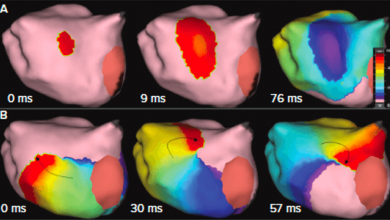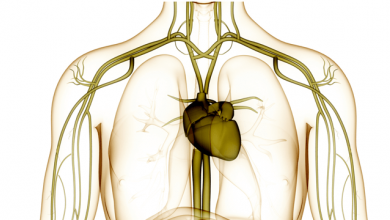Search results
Author(s):
Caroline H Roney
,
Andrew L Wit
,
Nicholas S Peters
Added:
3 years ago
Determining optimal treatment strategies for complex arrhythmogenesis in AF is confounded by the lack of consensus on the mechanisms causing AF. Fundamental to defining arrhythmogenic mechanisms of AF are the distinctions and interplay between functional features (determined by the electrophysiology of a cell) and structural features (determined by whether a structural or anatomical feature is…
View more
Author(s):
Michael Timothy Brian Pope
,
Timothy Rider Betts
Added:
1 year ago
Drivers of Atrial Fibrillation
Author(s):
Ian Mann
,
Belinda Sandler
,
Nick WF Linton
,
et al
Added:
3 years ago
Article
Author(s):
Jonathan W Waks
,
Mark E Josephson
Added:
3 years ago
Atrial fibrillation (AF), the most common sustained arrhythmia, is a leading cause of stroke, and is associated with significant morbidity and mortality worldwide. Despite its frequency, clinical importance, and advances in technology and our knowledge of the molecular, ionic and physiological fundamentals of cardiac electrophysiology, our limited understanding of the mechanisms that initiate and…
View more
Author(s):
Nadeev Wijesuriya
,
Nikos Papageorgiou
,
Edd Maclean
,
et al
Added:
3 years ago
AF is the most common arrhythmia and about 10% of the general population above the age of 65 years are affected by this condition.1 The mortality and morbidity of AF is well established, with a higher risk of stroke and heart failure in older patients with comorbidities.2 The pathophysiology of AF is complex and variable, making its management extremely challenging. Epidemiological studies have…
View more
Author(s):
Jing Xian Quah
,
Dhani Dharmaprani
,
Anandaroop Lahiri
,
et al
Added:
2 years ago
Author(s):
Seigo Yamashita
,
Ashok J Shah
,
Saagar Mahida
,
et al
Added:
3 years ago
Catheter ablation therapy has been widely used for rhythm control in patients with atrial fibrillation(AF).1 Since the first report in 1994,2 several interventional techniques have been proposed for AF, including replication of the surgical Maze,2 targeting pulmonary vein (PV) foci,3 segmental ostial and circumferential PV isolation,4,5 ganglionated plexi ablation,6 linear lesions in the left…
View more
Author(s):
Manav Sohal
,
Rajin Choudhury
,
Philippe Taghji
,
et al
Added:
3 years ago
Ablative therapies for atrial fibrillation have gained popularity worldwide and prompted the development of new, and often complex, tools to achieve higher levels of success. Pulmonary vein (PV) isolation is widely considered as the cornerstone of successful catheter ablation based on seminal work by Haissaguerre et al.1 Successful isolation of the PVs is now the most commonly sought endpoint in…
View more
Author(s):
Rakesh Latchamsetty
,
Fred Morady
Added:
3 years ago
Catheter ablation of AF has shown steady growth over the past two decades with a nearly 15 % annual increase in the US.1 This growth can be attributed in large part to four factors: an increase in operators and institutions performing the procedure;2 a steady rise in AF prevalence, which is predicted to reach 12 million in the US by 2030;3 a larger spectrum of AF patients with more complex atrial…
View more
Author(s):
Junaid Zaman
,
Andrew Grace
,
Sanjiv M Narayan
Added:
1 year ago















